
Illustrative Math Alignment: Grade 6 Unit 1
Dividing Fractions
Lesson 17: Fitting Boxes into Boxes
Use the following Media4Math resources with this Illustrative Math lesson.
| Thumbnail Image | Title | Body | Curriculum Nodes |
|---|---|---|---|
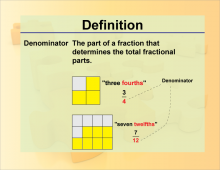
|
Definition--Fraction Concepts--Denominator | DenominatorTopicFractions DefinitionThe denominator is the bottom number in a fraction that indicates into how many equal parts the whole is divided. DescriptionIn the context of fractions, the denominator plays a crucial role in understanding the size and division of the whole. It represents the total number of equal parts that make up a whole. For instance, in the fraction 3/4, the denominator is 4, indicating that the whole is divided into four equal parts. The numerator, which is 3 in this example, tells us how many of those parts are being considered. |
Fractions and Mixed Numbers |
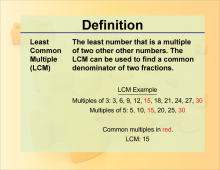
|
Definition--Fraction Concepts--Least Common Multiple (LCM) | Least Common Multiple (LCM)TopicFractions DefinitionThe Least Common Multiple (LCM) of two or more numbers is the smallest number that is a multiple of each of the numbers. DescriptionThe concept of the Least Common Multiple (LCM) is fundamental in the study of fractions. It is particularly useful when adding, subtracting, or comparing fractions. The LCM helps in finding a common denominator, which is essential for performing these operations with fractions. |
Fractions and Mixed Numbers |

|
Definition--Fraction Concepts--Least Common Multiple (LCM) | Least Common Multiple (LCM)TopicFractions DefinitionThe Least Common Multiple (LCM) of two or more numbers is the smallest number that is a multiple of each of the numbers. DescriptionThe concept of the Least Common Multiple (LCM) is fundamental in the study of fractions. It is particularly useful when adding, subtracting, or comparing fractions. The LCM helps in finding a common denominator, which is essential for performing these operations with fractions. |
Fractions and Mixed Numbers |

|
Definition--Fraction Concepts--Denominator | DenominatorTopicFractions DefinitionThe denominator is the bottom number in a fraction that indicates into how many equal parts the whole is divided. DescriptionIn the context of fractions, the denominator plays a crucial role in understanding the size and division of the whole. It represents the total number of equal parts that make up a whole. For instance, in the fraction 3/4, the denominator is 4, indicating that the whole is divided into four equal parts. The numerator, which is 3 in this example, tells us how many of those parts are being considered. |
Fractions and Mixed Numbers |
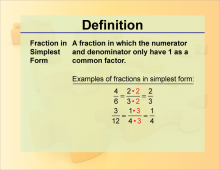
|
Definition--Fraction Concepts--Fraction in Simplest Form | Fraction in Simplest FormTopicFractions DefinitionA fraction is in its simplest form when the numerator and denominator have no common divisor other than 1. DescriptionIn mathematics, fractions represent parts of a whole. A fraction is composed of a numerator (the top number) and a denominator (the bottom number). Simplifying a fraction means reducing it to its simplest form, where the numerator and denominator have no common factors other than 1. For example, the fraction 4/8 can be simplified to 1/2 by dividing both the numerator and the denominator by their greatest common divisor, which is 4. |
Fractions and Mixed Numbers |

|
Definition--Fraction Concepts--Greatest Common Factor (GCF) | Greatest Common Factor (GCF)TopicFractions DefinitionThe Greatest Common Factor (GCF) is the highest number that divides exactly into two or more numbers without leaving a remainder. DescriptionThe concept of the Greatest Common Factor (GCF) is crucial in the study of fractions. It is used to simplify fractions to their lowest terms, making them easier to work with and understand. When two or more fractions have the same GCF, it means they share a common factor that can be used to reduce each fraction to its simplest form. This process is essential for performing operations such as addition, subtraction, multiplication, and division of fractions. |
Fractions and Mixed Numbers |

|
Definition--Fraction Concepts--Greatest Common Factor (GCF) | Greatest Common Factor (GCF)TopicFractions DefinitionThe Greatest Common Factor (GCF) is the highest number that divides exactly into two or more numbers without leaving a remainder. DescriptionThe concept of the Greatest Common Factor (GCF) is crucial in the study of fractions. It is used to simplify fractions to their lowest terms, making them easier to work with and understand. When two or more fractions have the same GCF, it means they share a common factor that can be used to reduce each fraction to its simplest form. This process is essential for performing operations such as addition, subtraction, multiplication, and division of fractions. |
Fractions and Mixed Numbers |

|
Definition--Fraction Concepts--Denominator | DenominatorTopicFractions DefinitionThe denominator is the bottom number in a fraction that indicates into how many equal parts the whole is divided. DescriptionIn the context of fractions, the denominator plays a crucial role in understanding the size and division of the whole. It represents the total number of equal parts that make up a whole. For instance, in the fraction 3/4, the denominator is 4, indicating that the whole is divided into four equal parts. The numerator, which is 3 in this example, tells us how many of those parts are being considered. |
Fractions and Mixed Numbers |
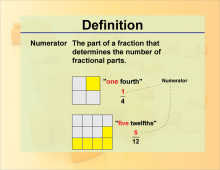
|
Definition--Fraction Concepts--Numerator | Definition--Fraction Concepts--NumeratorTopicFractions DefinitionThe numerator is the top number in a fraction, representing the number of parts being considered out of the whole. DescriptionIn the realm of fractions, the numerator plays a crucial role. It is the number above the fraction bar, indicating how many parts of the whole are being counted. For instance, in the fraction 3/4, the numerator is 3, which means three parts out of a total of four parts are being considered. Understanding the numerator is fundamental to grasping the concept of fractions, as it directly affects the value and representation of the fraction. |
Fractions and Mixed Numbers |

|
Definition--Fraction Concepts--Least Common Multiple (LCM) | Least Common Multiple (LCM)TopicFractions DefinitionThe Least Common Multiple (LCM) of two or more numbers is the smallest number that is a multiple of each of the numbers. DescriptionThe concept of the Least Common Multiple (LCM) is fundamental in the study of fractions. It is particularly useful when adding, subtracting, or comparing fractions. The LCM helps in finding a common denominator, which is essential for performing these operations with fractions. |
Fractions and Mixed Numbers |
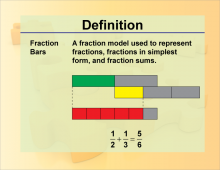
|
Definition--Fraction Concepts--Fraction Bars | Fraction BarsTopicFraction Concepts DefinitionFraction bars are visual representations of fractions that use rectangular bars divided into equal parts to illustrate fractional quantities. DescriptionFraction bars are essential tools in understanding and visualizing fractions, playing a crucial role in developing fraction concepts. These visual aids consist of rectangular bars divided into equal parts, with each part representing a unit fraction of the whole. The image showcases three fraction bar types illustrating halves, thirds, and sixths, clearly demonstrating how the denominator determines the number of equal parts in each bar. |
Fractions and Mixed Numbers |

|
Definition--Fraction Concepts--Numerator | Definition--Fraction Concepts--NumeratorTopicFractions DefinitionThe numerator is the top number in a fraction, representing the number of parts being considered out of the whole. DescriptionIn the realm of fractions, the numerator plays a crucial role. It is the number above the fraction bar, indicating how many parts of the whole are being counted. For instance, in the fraction 3/4, the numerator is 3, which means three parts out of a total of four parts are being considered. Understanding the numerator is fundamental to grasping the concept of fractions, as it directly affects the value and representation of the fraction. |
Fractions and Mixed Numbers |

|
Definition--Fraction Concepts--Greatest Common Factor (GCF) | Greatest Common Factor (GCF)TopicFractions DefinitionThe Greatest Common Factor (GCF) is the highest number that divides exactly into two or more numbers without leaving a remainder. DescriptionThe concept of the Greatest Common Factor (GCF) is crucial in the study of fractions. It is used to simplify fractions to their lowest terms, making them easier to work with and understand. When two or more fractions have the same GCF, it means they share a common factor that can be used to reduce each fraction to its simplest form. This process is essential for performing operations such as addition, subtraction, multiplication, and division of fractions. |
Fractions and Mixed Numbers |

|
Definition--Fraction Concepts--Least Common Multiple (LCM) | Least Common Multiple (LCM)TopicFractions DefinitionThe Least Common Multiple (LCM) of two or more numbers is the smallest number that is a multiple of each of the numbers. DescriptionThe concept of the Least Common Multiple (LCM) is fundamental in the study of fractions. It is particularly useful when adding, subtracting, or comparing fractions. The LCM helps in finding a common denominator, which is essential for performing these operations with fractions. |
Fractions and Mixed Numbers |

|
Collections in a Box: Fractions | This cheat sheet gathers together a number of resources on the topic of fractions. See the descriptions and links below. Each link takes you to a collection of resources around that topic. The middle column indicates the number of resources available and the third column takes you to page on Media4Math where those resources can be found. Subscribers can download the PDF version of this cheat sheet. Click Preview to see the HTML version. |
Add and Subtract Fractions, Add and Subtract Mixed Numbers, Compare and Order Fractions, Find Equivalent Fractions, Fractions and Mixed Numbers, Relate Fractions to Decimals and Write Fractions in Lowest Terms |

|
Collections in a Box: Fractions | This cheat sheet gathers together a number of resources on the topic of fractions. See the descriptions and links below. Each link takes you to a collection of resources around that topic. The middle column indicates the number of resources available and the third column takes you to page on Media4Math where those resources can be found. Subscribers can download the PDF version of this cheat sheet. Click Preview to see the HTML version. |
Add and Subtract Fractions, Add and Subtract Mixed Numbers, Compare and Order Fractions, Find Equivalent Fractions, Fractions and Mixed Numbers, Relate Fractions to Decimals and Write Fractions in Lowest Terms |

|
Collections in a Box: Fractions | This cheat sheet gathers together a number of resources on the topic of fractions. See the descriptions and links below. Each link takes you to a collection of resources around that topic. The middle column indicates the number of resources available and the third column takes you to page on Media4Math where those resources can be found. Subscribers can download the PDF version of this cheat sheet. Click Preview to see the HTML version. |
Add and Subtract Fractions, Add and Subtract Mixed Numbers, Compare and Order Fractions, Find Equivalent Fractions, Fractions and Mixed Numbers, Relate Fractions to Decimals and Write Fractions in Lowest Terms |

|
Collections in a Box: Fractions | This cheat sheet gathers together a number of resources on the topic of fractions. See the descriptions and links below. Each link takes you to a collection of resources around that topic. The middle column indicates the number of resources available and the third column takes you to page on Media4Math where those resources can be found. Subscribers can download the PDF version of this cheat sheet. Click Preview to see the HTML version. |
Add and Subtract Fractions, Add and Subtract Mixed Numbers, Compare and Order Fractions, Find Equivalent Fractions, Fractions and Mixed Numbers, Relate Fractions to Decimals and Write Fractions in Lowest Terms |

|
Collections in a Box: Fractions | This cheat sheet gathers together a number of resources on the topic of fractions. See the descriptions and links below. Each link takes you to a collection of resources around that topic. The middle column indicates the number of resources available and the third column takes you to page on Media4Math where those resources can be found. Subscribers can download the PDF version of this cheat sheet. Click Preview to see the HTML version. |
Add and Subtract Fractions, Add and Subtract Mixed Numbers, Compare and Order Fractions, Find Equivalent Fractions, Fractions and Mixed Numbers, Relate Fractions to Decimals and Write Fractions in Lowest Terms |

|
Collections in a Box: Fractions | This cheat sheet gathers together a number of resources on the topic of fractions. See the descriptions and links below. Each link takes you to a collection of resources around that topic. The middle column indicates the number of resources available and the third column takes you to page on Media4Math where those resources can be found. Subscribers can download the PDF version of this cheat sheet. Click Preview to see the HTML version. |
Add and Subtract Fractions, Add and Subtract Mixed Numbers, Compare and Order Fractions, Find Equivalent Fractions, Fractions and Mixed Numbers, Relate Fractions to Decimals and Write Fractions in Lowest Terms |

|
Collections in a Box: Fractions | This cheat sheet gathers together a number of resources on the topic of fractions. See the descriptions and links below. Each link takes you to a collection of resources around that topic. The middle column indicates the number of resources available and the third column takes you to page on Media4Math where those resources can be found. Subscribers can download the PDF version of this cheat sheet. Click Preview to see the HTML version. |
Add and Subtract Fractions, Add and Subtract Mixed Numbers, Compare and Order Fractions, Find Equivalent Fractions, Fractions and Mixed Numbers, Relate Fractions to Decimals and Write Fractions in Lowest Terms |
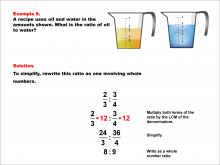
|
Math Example--Ratios and Rates--Ratios with Fractions--Example 8 | Ratios with Fractions--Example 8TopicRatios and Fractions DescriptionIn many scenarios, ratios are expressed using whole numbers, yet there are instances, like in recipes, where fractions play a significant role. This example illustrates a ratio involving fractions and demonstrates how to convert it into a ratio with whole numbers. Students will engage in understanding the process of converting these fractions to whole numbers, enhancing their comprehension of ratios and their practical applications such as cooking or mixing. The focus is on the fundamental skill of fraction conversion and applying it in a ratio context. |
Ratios and Rates |
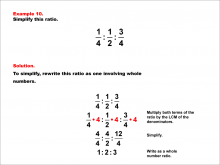
|
Math Example--Ratios and Rates--Ratios with Fractions--Example 10 | +Ratios with Fractions--Example 10TopicRatios and Fractions DescriptionIn many scenarios, ratios are expressed using whole numbers, yet there are instances, like in recipes, where fractions play a significant role. This example illustrates a ratio involving fractions and demonstrates how to convert it into a ratio with whole numbers. Students will engage in understanding the process of converting these fractions to whole numbers, enhancing their comprehension of ratios and their practical applications such as cooking or mixing. The focus is on the fundamental skill of fraction conversion and applying it in a ratio context. |
Ratios and Rates |
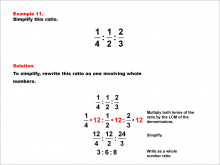
|
Math Example--Ratios and Rates--Ratios with Fractions--Example 11 | Ratios with Fractions--Example 11TopicRatios and Fractions DescriptionIn many scenarios, ratios are expressed using whole numbers, yet there are instances, like in recipes, where fractions play a significant role. This example illustrates a ratio involving fractions and demonstrates how to convert it into a ratio with whole numbers. Students will engage in understanding the process of converting these fractions to whole numbers, enhancing their comprehension of ratios and their practical applications such as cooking or mixing. The focus is on the fundamental skill of fraction conversion and applying it in a ratio context. |
Ratios and Rates |
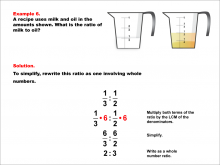
|
Math Example--Ratios and Rates--Ratios with Fractions--Example 6 | Ratios with Fractions--Example 6TopicRatios and Fractions DescriptionIn many scenarios, ratios are expressed using whole numbers, yet there are instances, like in recipes, where fractions play a significant role. This example illustrates a ratio involving fractions and demonstrates how to convert it into a ratio with whole numbers. Students will engage in understanding the process of converting these fractions to whole numbers, enhancing their comprehension of ratios and their practical applications such as cooking or mixing. The focus is on the fundamental skill of fraction conversion and applying it in a ratio context. |
Ratios and Rates |
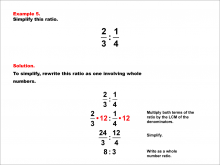
|
Math Example--Ratios and Rates--Ratios with Fractions--Example 5 | Ratios with Fractions--Example 5TopicRatios and Fractions DescriptionIn many scenarios, ratios are expressed using whole numbers, yet there are instances, like in recipes, where fractions play a significant role. This example illustrates a ratio involving fractions and demonstrates how to convert it into a ratio with whole numbers. Students will engage in understanding the process of converting these fractions to whole numbers, enhancing their comprehension of ratios and their practical applications such as cooking or mixing. The focus is on the fundamental skill of fraction conversion and applying it in a ratio context. |
Ratios and Rates |
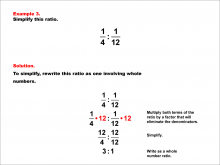
|
Math Example--Ratios and Rates--Ratios with Fractions--Example 3 | Ratios with Fractions--Example 3TopicRatios and Fractions DescriptionIn many scenarios, ratios are expressed using whole numbers, yet there are instances, like in recipes, where fractions play a significant role. This example illustrates a ratio involving fractions and demonstrates how to convert it into a ratio with whole numbers. Students will engage in understanding the process of converting these fractions to whole numbers, enhancing their comprehension of ratios and their practical applications such as cooking or mixing. The focus is on the fundamental skill of fraction conversion and applying it in a ratio context. |
Ratios and Rates |
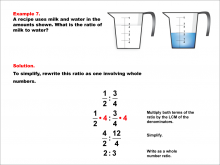
|
Math Example--Ratios and Rates--Ratios with Fractions--Example 7 | Ratios with Fractions--Example 7TopicRatios and Fractions DescriptionIn many scenarios, ratios are expressed using whole numbers, yet there are instances, like in recipes, where fractions play a significant role. This example illustrates a ratio involving fractions and demonstrates how to convert it into a ratio with whole numbers. Students will engage in understanding the process of converting these fractions to whole numbers, enhancing their comprehension of ratios and their practical applications such as cooking or mixing. The focus is on the fundamental skill of fraction conversion and applying it in a ratio context. |
Ratios and Rates |
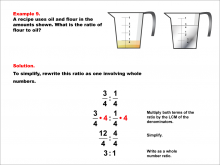
|
Math Example--Ratios and Rates--Ratios with Fractions--Example 9 | Ratios with Fractions--Example 9TopicRatios and Fractions DescriptionIn many scenarios, ratios are expressed using whole numbers, yet there are instances, like in recipes, where fractions play a significant role. This example illustrates a ratio involving fractions and demonstrates how to convert it into a ratio with whole numbers. Students will engage in understanding the process of converting these fractions to whole numbers, enhancing their comprehension of ratios and their practical applications such as cooking or mixing. The focus is on the fundamental skill of fraction conversion and applying it in a ratio context. |
Ratios and Rates |
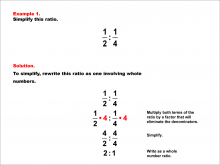
|
Math Example--Ratios and Rates--Ratios with Fractions--Example 1 | Ratios with Fractions--Example 1TopicRatios and Fractions DescriptionIn many scenarios, ratios are expressed using whole numbers, yet there are instances, like in recipes, where fractions play a significant role. This example illustrates a ratio involving fractions and demonstrates how to convert it into a ratio with whole numbers. Students will engage in understanding the process of converting these fractions to whole numbers, enhancing their comprehension of ratios and their practical applications such as cooking or mixing. The focus is on the fundamental skill of fraction conversion and applying it in a ratio context. |
Ratios and Rates |
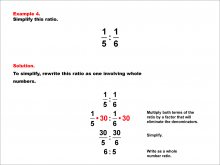
|
Math Example--Ratios and Rates--Ratios with Fractions--Example 4 | Ratios with Fractions--Example 4TopicRatios and Fractions DescriptionIn many scenarios, ratios are expressed using whole numbers, yet there are instances, like in recipes, where fractions play a significant role. This example illustrates a ratio involving fractions and demonstrates how to convert it into a ratio with whole numbers. Students will engage in understanding the process of converting these fractions to whole numbers, enhancing their comprehension of ratios and their practical applications such as cooking or mixing. The focus is on the fundamental skill of fraction conversion and applying it in a ratio context. |
Ratios and Rates |
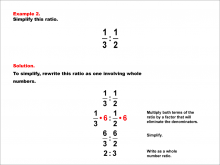
|
Math Example--Ratios and Rates--Ratios with Fractions--Example 2 | Ratios with Fractions--Example 2TopicRatios and Fractions DescriptionIn many scenarios, ratios are expressed using whole numbers, yet there are instances, like in recipes, where fractions play a significant role. This example illustrates a ratio involving fractions and demonstrates how to convert it into a ratio with whole numbers. Students will engage in understanding the process of converting these fractions to whole numbers, enhancing their comprehension of ratios and their practical applications such as cooking or mixing. The focus is on the fundamental skill of fraction conversion and applying it in a ratio context. |
Ratios and Rates |
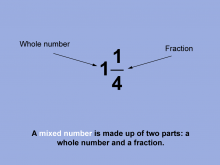
|
Math Clip Art--Fraction Concepts--Mixed Numbers 02 | Math Clip Art--Fraction Concepts--Mixed Numbers 02TopicFractions DescriptionThis image presents the mixed number 1 1/4 with the whole number part labeled and the fraction part clearly identified. It shows the number 1 1/4 with arrows or labels pointing to the '1' as the whole number part and '1/4' as the fraction part. This representation helps students understand the structure of mixed numbers, showing how they combine a whole number with a proper fraction. It provides a clear visual breakdown of the components of a mixed number. |
Fractions and Mixed Numbers |
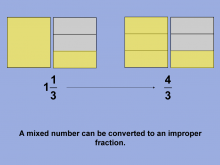
|
Math Clip Art--Fraction Concepts--Mixed Numbers 09 | Math Clip Art--Fraction Concepts--Mixed Numbers 09TopicFractions DescriptionThis image shows rectangular models demonstrating how 1 1/3 can be converted to 4/3, illustrating that a mixed number can also be written as an improper fraction. It displays one whole rectangle plus a third of another rectangle, alongside a model showing four thirds. This representation helps students visualize the process of converting mixed numbers to improper fractions. It reinforces the idea that mixed numbers and improper fractions can represent the same quantity. |
Fractions and Mixed Numbers |
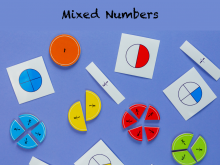
|
Math Clip Art--Fraction Concepts--Mixed Numbers 01 | Math Clip Art--Fraction Concepts--Mixed Numbers 01TopicFractions DescriptionThis image serves as the title card for a series on mixed numbers. It displays the text "Mixed Numbers" in a clear, prominent font. The background may include subtle mathematical elements or fraction-related graphics to set the context for the following images in the series. This introductory image sets the stage for the subsequent images, preparing students for an exploration of mixed numbers, which combine whole numbers and fractions. It provides a clear, concise title that immediately informs viewers about the specific fraction concepts they'll be studying. |
Fractions and Mixed Numbers |
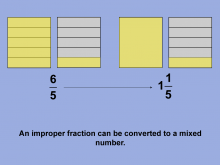
|
Math Clip Art--Fraction Concepts--Mixed Numbers 06 | Math Clip Art--Fraction Concepts--Mixed Numbers 06TopicFractions DescriptionThis image presents rectangular models for 6/5 and 1 1/5. It shows two sets of rectangles: one modeling 6/5 and the other modeling 1 1/5. This representation helps students visualize the relationship between improper fractions and mixed numbers. It demonstrates how an improper fraction like 6/5 can be expressed as a mixed number 1 1/5, showing that they represent the same quantity. Teachers can use this image to discuss the conversion between improper fractions and mixed numbers, and to reinforce the concept that mixed numbers represent quantities greater than one whole. |
Fractions and Mixed Numbers |

|
Math Clip Art--Fraction Concepts--Mixed Numbers 09 | Math Clip Art--Fraction Concepts--Mixed Numbers 09TopicFractions DescriptionThis image shows rectangular models demonstrating how 1 1/3 can be converted to 4/3, illustrating that a mixed number can also be written as an improper fraction. It displays one whole rectangle plus a third of another rectangle, alongside a model showing four thirds. This representation helps students visualize the process of converting mixed numbers to improper fractions. It reinforces the idea that mixed numbers and improper fractions can represent the same quantity. |
Fractions and Mixed Numbers |

|
Math Clip Art--Fraction Concepts--Mixed Numbers 10 | Math Clip Art--Fraction Concepts--Mixed Numbers 10TopicFractions DescriptionThis image shows the numerical manipulation of converting 1 2/5 to 7/5. It displays the step-by-step process of multiplying the whole number by the denominator, adding the numerator, and then writing this over the original denominator. This representation helps students understand the mathematical process behind converting mixed numbers to improper fractions. It provides a clear, numerical approach to complement the visual models seen in previous images. Teachers can use this image to explain the algorithm for converting mixed numbers to improper fractions and to reinforce the connection between multiplication and fractions. |
Fractions and Mixed Numbers |

|
Math Clip Art--Fraction Concepts--Mixed Numbers 08 | Math Clip Art--Fraction Concepts--Mixed Numbers 08TopicFractions DescriptionThis image is a variation of the previous one, now showing the conversion of 12/5 to 2 2/5. It displays the step-by-step process of dividing 12 by 5 to get 2 with a remainder of 2, which then becomes the numerator of the fractional part. This representation builds on the previous example, helping students see how the process works with larger numbers. It reinforces the concept that the whole number part of a mixed number comes from how many times the denominator goes into the numerator. |
Fractions and Mixed Numbers |
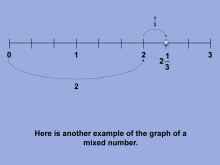
|
Math Clip Art--Fraction Concepts--Mixed Numbers 05 | Math Clip Art--Fraction Concepts--Mixed Numbers 05TopicFractions DescriptionThis image presents a variation with 2 1/3 graphed on the number line. It shows a number line with whole numbers marked, and a point clearly indicated at 2 1/3, which would be one-third of the way from 2 to 3. This representation builds on the previous examples, helping students visualize a different mixed number on the number line. It reinforces the concept that mixed numbers can be located precisely between whole numbers and helps students understand how the fractional part determines the exact position. |
Fractions and Mixed Numbers |

|
Math Clip Art--Fraction Concepts--Mixed Numbers 02 | Math Clip Art--Fraction Concepts--Mixed Numbers 02TopicFractions DescriptionThis image presents the mixed number 1 1/4 with the whole number part labeled and the fraction part clearly identified. It shows the number 1 1/4 with arrows or labels pointing to the '1' as the whole number part and '1/4' as the fraction part. This representation helps students understand the structure of mixed numbers, showing how they combine a whole number with a proper fraction. It provides a clear visual breakdown of the components of a mixed number. |
Fractions and Mixed Numbers |
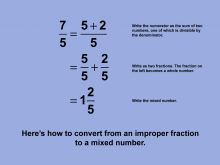
|
Math Clip Art--Fraction Concepts--Mixed Numbers 07 | Math Clip Art--Fraction Concepts--Mixed Numbers 07TopicFractions DescriptionThis image shows the numerical manipulation of 7/5 and converting it to 1 2/5. It displays the step-by-step process of dividing 7 by 5 to get 1 with a remainder of 2, which then becomes the numerator of the fractional part. This representation helps students understand the mathematical process behind converting improper fractions to mixed numbers. It provides a clear, numerical approach to complement the visual models seen in previous images. Teachers can use this image to explain the algorithm for converting improper fractions to mixed numbers and to reinforce the connection between division and fractions. |
Fractions and Mixed Numbers |
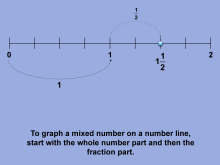
|
Math Clip Art--Fraction Concepts--Mixed Numbers 04 | Math Clip Art--Fraction Concepts--Mixed Numbers 04TopicFractions DescriptionThis image is a variation of the previous one, for 1 1/2, showing the whole number part on the number line and then the fractional part. It displays a number line with the whole number 1 clearly marked, and then shows how the additional 1/2 is added to reach the final position of 1 1/2. This representation helps students understand how mixed numbers are constructed on a number line, breaking down the process into two steps: locating the whole number, then adding the fraction. It reinforces the concept that mixed numbers combine whole numbers and fractions. |
Fractions and Mixed Numbers |

|
Math Clip Art--Fraction Concepts--Mixed Numbers 10 | Math Clip Art--Fraction Concepts--Mixed Numbers 10TopicFractions DescriptionThis image shows the numerical manipulation of converting 1 2/5 to 7/5. It displays the step-by-step process of multiplying the whole number by the denominator, adding the numerator, and then writing this over the original denominator. This representation helps students understand the mathematical process behind converting mixed numbers to improper fractions. It provides a clear, numerical approach to complement the visual models seen in previous images. Teachers can use this image to explain the algorithm for converting mixed numbers to improper fractions and to reinforce the connection between multiplication and fractions. |
Fractions and Mixed Numbers |
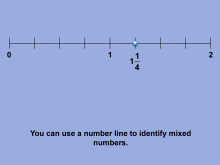
|
Math Clip Art--Fraction Concepts--Mixed Numbers 03 | Math Clip Art--Fraction Concepts--Mixed Numbers 03TopicFractions DescriptionThis image shows the graph of 1 1/4 on a number line. It displays a number line with whole numbers marked, and a point clearly indicated at 1 1/4, which would be halfway between 1 and 1 1/2. This representation helps students visualize where mixed numbers fall on a number line, reinforcing their understanding of how mixed numbers relate to whole numbers and fractions. It provides a concrete way to see that 1 1/4 is more than 1 but less than 2. Teachers can use this image to discuss how mixed numbers can be located on a number line and to reinforce the concept that mixed numbers represent values between whole numbers. |
Fractions and Mixed Numbers |
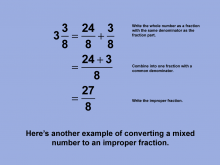
|
Math Clip Art--Fraction Concepts--Mixed Numbers 11 | Math Clip Art--Fraction Concepts--Mixed Numbers 11TopicFractions DescriptionThis image shows a variation of the previous concept, now converting 3 3/8 to 27/8. It displays the step-by-step process of multiplying 3 by 8 to get 24, adding 3, and then writing 27 over 8. This representation builds on the previous example, helping students see how the process works with larger mixed numbers. It reinforces the concept that the numerator of the resulting improper fraction will always be larger than the denominator when converting from a mixed number. |
Fractions and Mixed Numbers |

|
Math Clip Art--Fraction Concepts--Mixed Numbers 11 | Math Clip Art--Fraction Concepts--Mixed Numbers 11TopicFractions DescriptionThis image shows a variation of the previous concept, now converting 3 3/8 to 27/8. It displays the step-by-step process of multiplying 3 by 8 to get 24, adding 3, and then writing 27 over 8. This representation builds on the previous example, helping students see how the process works with larger mixed numbers. It reinforces the concept that the numerator of the resulting improper fraction will always be larger than the denominator when converting from a mixed number. |
Fractions and Mixed Numbers |

|
Math Clip Art--Fraction Concepts--Mixed Numbers 06 | Math Clip Art--Fraction Concepts--Mixed Numbers 06TopicFractions DescriptionThis image presents rectangular models for 6/5 and 1 1/5. It shows two sets of rectangles: one modeling 6/5 and the other modeling 1 1/5. This representation helps students visualize the relationship between improper fractions and mixed numbers. It demonstrates how an improper fraction like 6/5 can be expressed as a mixed number 1 1/5, showing that they represent the same quantity. Teachers can use this image to discuss the conversion between improper fractions and mixed numbers, and to reinforce the concept that mixed numbers represent quantities greater than one whole. |
Fractions and Mixed Numbers |

|
Math Clip Art--Fraction Concepts--Mixed Numbers 03 | Math Clip Art--Fraction Concepts--Mixed Numbers 03TopicFractions DescriptionThis image shows the graph of 1 1/4 on a number line. It displays a number line with whole numbers marked, and a point clearly indicated at 1 1/4, which would be halfway between 1 and 1 1/2. This representation helps students visualize where mixed numbers fall on a number line, reinforcing their understanding of how mixed numbers relate to whole numbers and fractions. It provides a concrete way to see that 1 1/4 is more than 1 but less than 2. Teachers can use this image to discuss how mixed numbers can be located on a number line and to reinforce the concept that mixed numbers represent values between whole numbers. |
Fractions and Mixed Numbers |

|
Math Clip Art--Fraction Concepts--Mixed Numbers 07 | Math Clip Art--Fraction Concepts--Mixed Numbers 07TopicFractions DescriptionThis image shows the numerical manipulation of 7/5 and converting it to 1 2/5. It displays the step-by-step process of dividing 7 by 5 to get 1 with a remainder of 2, which then becomes the numerator of the fractional part. This representation helps students understand the mathematical process behind converting improper fractions to mixed numbers. It provides a clear, numerical approach to complement the visual models seen in previous images. Teachers can use this image to explain the algorithm for converting improper fractions to mixed numbers and to reinforce the connection between division and fractions. |
Fractions and Mixed Numbers |